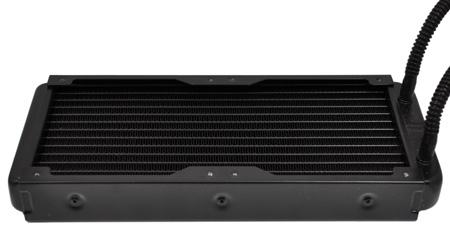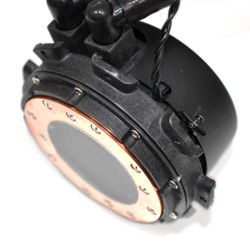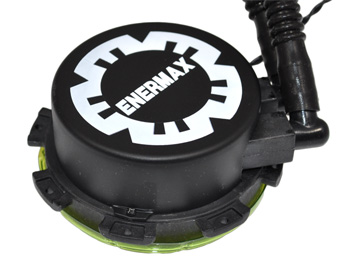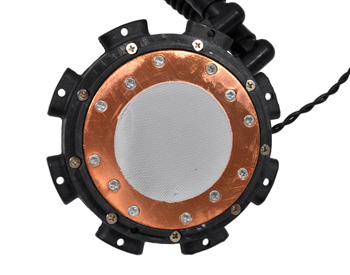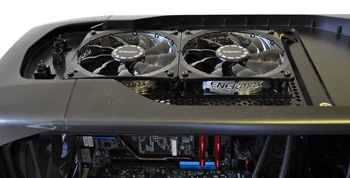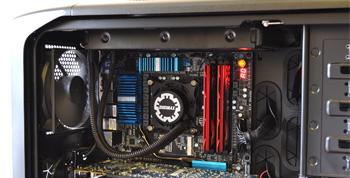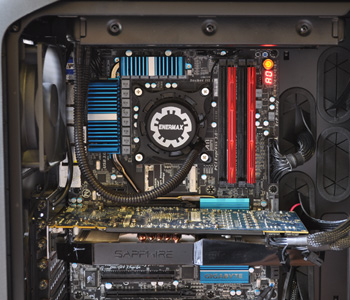A Closer Look
How can Enermax make the ELC240 truly different to the all-in-one liquid cooling solutions already on the market? The answer is to partner with a different vendor. While most of the competing solutions are manufactured by Asetek or CoolIT, Enermax has opted to team up with Asia Vital Components (AVC) - one of the world's largest suppliers of desktop CPU coolers.
AVC should certainly have the expertise required to produce a potent liquid cooler, but our sample did show signs of a pre-production unit. As pictured above right, a screw holding the pump cover in place snapped off far too easily; though, Enermax admits that its engineers had unscrewed the cap on this particular unit several times during testing. In other words, it isn't a problem that you're likely to experience during regular use.
On the plus side, Enermax claims its partnership with AVC has led to an innovation which improves heat dissipation . Whereas most existing solutions use a micro-fin structure that we know works well, Enermax has attempted to improve the flow of liquid inside the cold plate by adding four shunt channels that are designed to minimise obstructions.
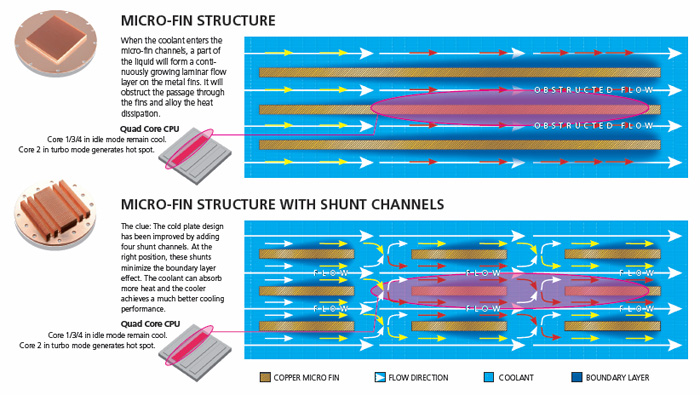
It's hard to envisage these minor alterations making a big difference to cooling performance, but in this market every degree counts, and we appreciate the fact that Enermax is trying to differentiate.
Performance aside, it's important that Enermax perfects the basic elements of all-in-one liquid cooling. The pump needs to be suitably small (or indeed tiny compared to some of the huge air coolers on the market), installation needs to be super-easy and the entire package needs to run as quiet as possible at all times.
The pump - which contains a 2,200 RPM motor - is certainly compact in size, but it isn't the best looking or most feature packed. It's personal preference, but we prefer the square design of Corsair's rival Hydro H100, which of course also includes an integrated fan controller for up to four fans.
Enermax, on the other hand, has kept it simple. A single cable with three four-pin connectors feeds out of the pump; the first header is attached to the motherboard to provide power and send RPM info to the BIOS, while the subsequent connectors are used to attach the two 120mm fans. This particular setup makes for an easy installation, but we suspect users wanting tighter control over the fans will connect them to a third-party controller.
Underneath the pump, thermal paste is neatly pre-applied to the the copper cold plate but there's no spare compound in the box, making subsequent installations a little more tricky. Going by the scuffs and scrapes on the copper, we suspect this pre-production sample has been through a fair few installations already.
Speaking of installation, getting the ELC240 up and running is extremely simple, provided you've ample room in your chassis. We're stating the obvious, but remember that a 240mm radiator is a chunky piece of kit - it'll be one of the largest single components in your build, and if you don't have a chassis designed with liquid cooling in mind, you might be faced with unwanted modifications.
Our regular test platform is built around a Corsair Graphite Series 600T chassis, and though it's big enough for every air cooler we've ever tried, a 240mm radiator does present a bit of a challenge. There isn't enough room for the radiator and fans to be mounted inside the case above the motherboard, but the chassis is designed with a workaround in mind; the radiator can be installed inside, with the fans attached from the outside where they sit beneath a mesh grill.
This particular configuration may or may not offer optimal performance, but with the fans pulling cool air in from outside the chassis, we expect to see the radiator perform well. Though, there is one foible to be aware of; the fan-speed control switch gets sandwiched between fan and radiator, making it almost impossible to reach after installation.
That bugbear aside, the radiator and fans are put in place easily enough - eight screws thread the units together - and the pump is fixed quickly, too. In keeping with most air coolers, a backplate is attached to the rear of the motherboard - both Intel and AMD backplates are provided - and a retention ring is then used to secure the pump. It's literally a case of lining it up and tightening four screws, it couldn't be any easier.
What's handy is that Enermax's 315mm-long Fluorinated Ethylene Propylene (FEP) tubes can be rotated at the pump, providing that extra bit of flexibility.
The advantages are clear; using the ELC240 leaves a lot of room to manoeuvre around the CPU socket, there's very little load on the motherboard tray, and cooling performance should be excellent. But there are disadvantages, too. The 240mm radiator needs a large chassis, having an extra two fans is likely to increase noise, and at £90 the ELC240 is a long way from cheap. But enough of the pros and cons, let's find out how it performs.






